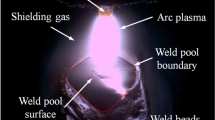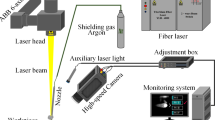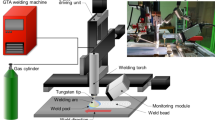Abstract
Accurate keyhole status prediction is critical for realizing the closed-loop control of the keyhole plasma arc welding (K-PAW) processes for acquiring full-penetration weld joints with high efficiency. Visually captured weld pool images from topside provide sufficient information of the liquid metal as well as keyhole behaviors. Weld pool, plasma arc, and keyhole entrance could be clearly recognized reflecting the different features during different keyholing stages. It was proposed to extract the image features automatically based on a deep learning algorithm rather than manually selecting characteristic parameters. Since directly training the deep CNN (convolutional neural network) model using the acquired data led to convergence failure, a well-trained generalized model was employed and fine-tuned accordingly to more easily extract the K-PAW image features. Model training was conducted using obtained dataset, which took weld pool images as input and penetration/keyhole status (partial penetration with a blind keyhole or full penetration with a through keyhole) as output. Underlying correlations between the penetration/keyhole status and topside weld pool images were established. For further verifying the effectiveness and reliability of the trained model, experiments were designed acquiring typical slow keyholing under constant welding current and rapid keyhole switching under pulse welding current. Based on the given data, the verified 90% accuracy was achieved for correctly predicting the keyhole/penetration status. Finally, the visualization of the convolutional layers was carried out, and displayed the features clearly, which is of great significance for understanding the internal mechanism of the neural network.




















Similar content being viewed by others
Data availability
The datasets used or analyzed during the current study are available from the corresponding author on reasonable request.
References
Metcalfe JC, Quigley MBC (1975) Heat-transfer in plasma-arc welding. Weld J 54:S99–S103
Zhang YM, Zhang SB (1999) Observation of the keyhole during plasma arc welding. Weld J 78:53s–58s
Wu CS, Jia CB, Chen MA (2010) A control system for keyhole plasma arc welding of stainless steel plates with medium thickness. Weld J 89:225s–231s
Martikainen JK, Moisio TJI (1993) Investigation of the effect of welding parameters on weld quality of plasma-arc keyhole welding of structural-steels. Weld J 72:S329–S340
Zhang YM, Liu YC (2007) Control of dynamic keyhole welding process. Automatica 43:876–884. https://doi.org/10.1016/j.automatica.2006.11.008
Steffens HD, Kayser IH (1972) Automatic-control for plasma arc-welding with constant keyhole diameter. Weld J 51:408
Zhang SB, Zhang YM (2001) Efflux plasma charge-based sensing and control of joint penetration during keyhole plasma arc welding. Weld J 80:157s–162s
Saad E, Wang HJ, Kovacevic R (2006) Classification of molten pool modes in variable polarity plasma arc welding based on acoustic signature. J Mater Process Technol 174:127–136. https://doi.org/10.1016/j.jmatprotec.2005.03.020
Zhang YM, Zhang SB, Liu YC (2001) A plasma cloud charge sensor for pulse keyhole process control. Meas Sci Technol 12:1365–1370. https://doi.org/10.1088/0957-0233/12/8/352
Zhang GK, Chen J, Wu CS (2017) Simultaneous sensing of weld pool and keyhole in controlled-pulse PAW: the behaviors of the keyhole and the weld pool in plasma arc welding can be used to indicate weld quality. Weld J 96:95s–103s
Zhang WJ, Xiao J, Zhang YM (2016) A mobile sensing system for real-time 3D weld pool surface measurement in manual GTAW. Meas Sci Technol 27:045102. https://doi.org/10.1088/0957-0233/27/4/045102
Saeed G, Zhang YM (2007) Weld pool surface depth measurement using a calibrated camera and structured light. Meas Sci Technol 18:2570–2578. https://doi.org/10.1088/0957-0233/18/8/033
Wu CS, Zhong LM, Gao JQ (2009) Visualization of hump formation in high-speed gas metal arc welding. Measurement Sci Technol 20. https://doi.org/10.1088/0957-0233/20/11/115702
Fabbro R, Slimani S, Coste F, Briand F (2005) Study of keyhole behaviour for full penetration Nd-Yag CW laser welding. J Physics D-Appl Physics 38:1881–1887. https://doi.org/10.1088/0022-3727/38/12/005
Krasnoperov MY, Pieters RRGM, Richardson IM (2004) Weld pool geometry during keyhole laser welding of thin steel sheets. Sci Technol Weld Join 9:501–506. https://doi.org/10.1179/136217104225021733
Kovacevic R, Zhang YM, Li L (1996) Monitoring of weld joint penetration based on weld pool geometrical appearance. Weld J 75:S317–S329
Zhang G, Shi Y, Gu YF, Fan D (2017) Welding torch attitude-based study of human welder interactive behavior with weld pool in GTAW. Robot Comput Integr Manuf 48:145–156. https://doi.org/10.1016/j.rcim.2017.03.009
Fan CJ, Lv FL, Chen SB (2009) Visual sensing and penetration control in aluminum alloy pulsed GTA welding. Int J Adv Manuf Technol 42:126–137. https://doi.org/10.1007/s00170-008-1587-1
Zhang W, Liu Y, Wang X, Zhang YM (2012) Characterization of three-dimensional weld pool surface in GTAW. Weld J 91:195s–203s
Wu S, Gao H, Zhang W, Zhang YM (2017) Analytic weld pool model calibrated by measurements - part 1: principles. Weld J 96:193s–202s
Li C, Wang Q, Jiao W, Johnson M, Zhang YM (2020) Deep learning-based detection of penetration from weld pool reflection images. Weld J 99:239s–245s. https://doi.org/10.29391/2020.99.022
Shevchik S, Le-Quang T, Meylan B, Farahani FV, Olbinado MP, Rack A, Masinelli G, Leinenbach C, Wasmer K (2020) Supervised deep learning for real-time quality monitoring of laser welding with X-ray radiographic guidance. Sci Rep 10. https://doi.org/10.1038/s41598-020-60294-x
Zeiler MD, Taylor GW, Fergus R (2011) Adaptive deconvolutional networks for mid and high level feature learning. 2011 Ieee International Conference on Computer Vision (Iccv): 2018–2025
Mahendran A, Vedaldi A (2015) Understanding deep image representations by inverting them. 2015 Ieee Conference on Computer Vision and Pattern Recognition (Cvpr): 5188–5196. https://doi.org/10.1109/cvpr.2015.7299155
Jia CB, Liu XF, Wu CS, Lin SB (2018) Stereo analysis on the keyhole and weld pool behaviors in K-PAW with triple CCD cameras. J Manuf Process 32:754–762. https://doi.org/10.1016/j.jmapro.2018.03.026
Liu XF, Jia CB, Wu CS, Zhang GK, Gao JQ (2017) Measurement of the keyhole entrance and topside weld pool geometries in keyhole plasma arc welding with dual CCD cameras. J Mater Process Technol 248:39–48. https://doi.org/10.1016/j.jmatprotec.2017.05.012
Hinton GE, Srivastava N, Krizhevsky A, Sutskever I, Salakhutdinov RR (2012) Improving neural networks by preventing co-adaptation of feature detectors. Comput Therm Sci 4:212–223
Krizhevsky A, Sutskever I, Hinton GE (2017) ImageNet classification with deep convolutional neural networks. Commun ACM 60:84–90. https://doi.org/10.1145/3065386
Srivastava N, Hinton G, Krizhevsky A, Sutskever I, Salakhutdinov R (2014) Dropout: a simple way to prevent neural networks from overfitting. J Mach Learn Res 15:1929–1958
Girshick R, Donahue J, Darrell T, Malik J (2014) Rich feature hierarchies for accurate object detection and semantic segmentation. 2014 Ieee Conference on Computer Vision and Pattern Recognition (Cvpr): 580–587. https://doi.org/10.1109/Cvpr.2014.81
Zeiler MD, Fergus R (2014) Visualizing and understanding convolutional networks. Comp Vis - Eccv 2014, Pt I 8689:818–833. https://doi.org/10.1007/978-3-319-10590-1-53
Yosinski J, Clune J, Nguyen AM, Fuchs TJ, Lipson H (2015) Understanding neural networks through deep visualization. Comp Vis Pattern Recognit. arXiv:1506.06579 [cs.CV]
Funding
This work was supported by the National Natural Science Foundation of China (grant no. 51975332), the Major Scientific and Technological Innovation Project of Shandong Province (2019JZZY010358), and the Aeronautical Science Foundation of China (201742Q3001).
Author information
Authors and Affiliations
Contributions
Chuanbao Jia: funding acquisition, project administration, resources, and supervision, and writing original draft. Xinfeng Liu: algorithm design, welding experiment. Guokai Zhang: welding experiment, and data curation. Yong Zhang: supplement experiments. Changhai Yu: complete and improve manuscript. Chuansong Wu: writing review and editing.
Corresponding author
Ethics declarations
Ethical approval
Ethical approval was not required for this study.
Consent to participate
Written informed consent was obtained from individual or guardian participants.
Consent to publish
The manuscript was approved by all authors for publication.
Competing interests
The authors declare no competing interests.
Additional information
Publisher’s note
Springer Nature remains neutral with regard to jurisdictional claims in published maps and institutional affiliations.
Appendix
Appendix
Rights and permissions
About this article
Cite this article
Jia, CB., Liu, XF., Zhang, GK. et al. Penetration/keyhole status prediction and model visualization based on deep learning algorithm in plasma arc welding. Int J Adv Manuf Technol 117, 3577–3597 (2021). https://doi.org/10.1007/s00170-021-07903-9
Received:
Accepted:
Published:
Issue Date:
DOI: https://doi.org/10.1007/s00170-021-07903-9




